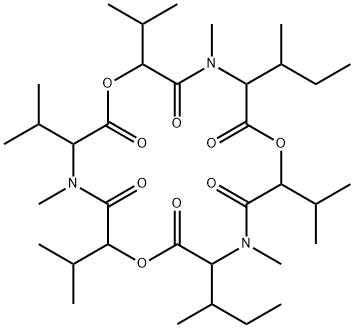Enniatins are cyclohexadepsipeptides commonly isolated from fungi that are known to have antibiotic properties and to induce apoptosis in several cancer lines. Many function as ionophores, forming pores in cellular membranes to allow selective ion transport. Enniatin A1 is one of four major analogs in the enniatin complex ns are cyclohexadepsipeptides commonly isolated from fungi that are known to have antibiotic properties and to induce apoptosis in several cancer lines. Many function as ionophores, forming pores in cellular membranes to allow selective ion transport. Enniatin A1 is one of four major analogs in the enniatin complex ns are cyclohexadepsipeptides commonly isolated from fungi that are known to have antibiotic properties and to induce apoptosis in several cancer lines. Many function as ionophores, forming pores in cellular membranes to allow selective ion transport. Enniatin A1 is one of four major analogs in the enniatin complex ns are cyclohexadepsipeptides commonly isolated from fungi that are known to have antibiotic properties and to induce apoptosis in several cancer lines. Many function as ionophores, forming pores in cellular membranes to allow selective ion transport. Enniatin A1 is one of four major analogs in the enniatin complex ns are cyclohexadepsipeptides commonly isolated from fungi that are known to have antibiotic properties and to induce apoptosis in several cancer lines. Many function as ionophores, forming pores in cellular membranes to allow selective ion transport. Enniatin A1 is one of four major analogs in the enniatin complex ns are cyclohexadepsipeptides commonly isolated from fungi that are known to have antibiotic properties and to induce apoptosis in several cancer lines. Many function as ionophores, forming pores in cellular membranes to allow selective ion transport. Enniatin A1 is one of four major analogs in the enniatin complex ns are cyclohexadepsipeptides commonly isolated from fungi that are known to have antibiotic properties and to induce apoptosis in several cancer lines. Many function as ionophores, forming pores in cellular membranes to allow selective ion transport. Enniatin A1 is one of four major analogs in the enniatin complex ns are cyclohexadepsipeptides commonly isolated from fungi that are known to have antibiotic properties and to induce apoptosis in several cancer lines. Many function as ionophores, forming pores in cellular membranes to allow selective ion transport. Enniatin A1 is one of four major analogs in the enniatin complex ns are cyclohexadepsipeptides commonly isolated from fungi that are known to have antibiotic properties and to induce apoptosis in several cancer lines. Many function as ionophores, forming pores in cellular membranes to allow selective ion transport. Enniatin A1 is one of four major analogs in the enniatin complex ns are cyclohexadepsipeptides commonly isolated from fungi that are known to have antibiotic properties and to induce apoptosis in several cancer lines. Many function as ionophores, forming pores in cellular membranes to allow selective ion transport. Enniatin A1 is one of four major analogs in the enniatin complex ns are cyclohexadepsipeptides commonly isolated from fungi that are known to have antibiotic properties and to induce apoptosis in several cancer lines. Many function as ionophores, forming pores in cellular membranes to allow selective ion transport. Enniatin A1 is one of four major analogs in the enniatin complex ns are cyclohexadepsipeptides commonly isolated from fungi that are known to have antibiotic properties and to induce apoptosis in several cancer lines. Many function as ionophores, forming pores in cellular membranes to allow selective ion transport. Enniatin A1 is one of four major analogs in the enniatin complex ns are cyclohexadepsipeptides commonly isolated from fungi that are known to have antibiotic properties and to induce apoptosis in several cancer lines. Many function as ionophores, forming

